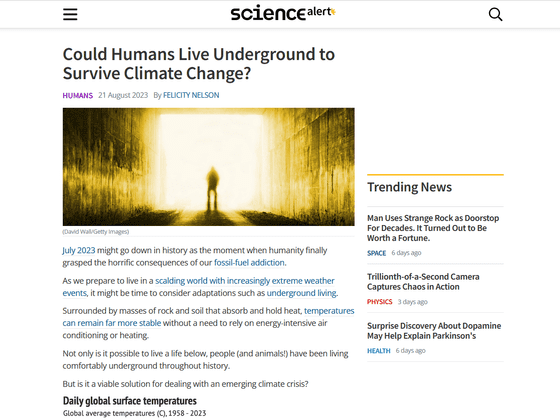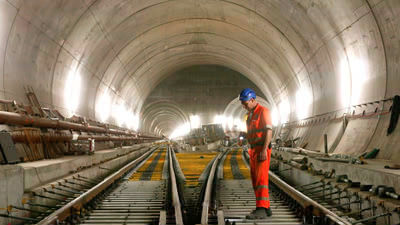Can humans survive climate change by living in 'underground space'?

In 2023, record-breaking heat will continue, and extremely strong heat waves are being observed around the world, with
Could Humans Live Underground to Survive Climate Change?
https://www.sciencealert.com/could-humans-live-underground-to-survive-climate-change

In
Coober Pedy's underground space, which is stable at an average of 23 degrees all year round, contains living spaces, large lounges and swimming pools.

by
Coober Pedy stipulates that living spaces must be built at least 2.5 meters below the ground to prevent bedrock collapse. However, rock collapses still occur occasionally.
In Cappadocia , Turkey, an 18-story underground city built around 2000 BC was discovered in 1963. The city, named Derinkuyu , has churches, stables, warehouses and living quarters, and has been used for thousands of years as a wartime refuge for up to 20,000 people. It is believed that

by
While the outdoor temperature in Cappadocia reaches a maximum of 30°C in summer and a minimum of 0°C in winter, the temperature inside Derinkuyu remains stable at an average of 13°C all year round. It is used as a storage facility for pears, potatoes, lemons, oranges and apples.
On the other hand, Science Alert explains the difficulty of 'living underground forever'. Science Alert points out that being in a cramped underground space can lead to claustrophobia and hazards such as poor ventilation and ground collapse.
“Our bodies, both biologically and physiologically, are living underground,” says Will Hunt, author of Underground: A Human History of the Worlds Beneath Our Feet. It has not been designed to withstand the life of a million people.'
One of the risks of living underground is 'not being exposed to sunlight'. It has been reported that humans can sleep up to 30 hours at a time in underground spaces where sunlight does not enter, and it has been pointed out that it may lead to disruption of life rhythms. It is also speculated that health problems may be caused because vitamin D , which is synthesized by sun exposure, is not produced.

In underground spaces, there is also the concern of “ flash floods ”. A flash flood is a phenomenon in which a river suddenly rises due to heavy rain. In Las Vegas, USA, about 1,500 homeless people live in tunnels that carry rainwater, but flash floods have caused fatal accidents many times so far. Because flash floods occur suddenly in tunnels, people do not have time to evacuate and are affected by flash floods. As the scale of hurricanes increases due to climate change, there are concerns that flash floods may cause damage even in underground spaces where flash floods have never occurred before.
Furthermore, it has been reported that the temperature in the underground space is influenced by the activities on the ground. According to Alessandro Lotta Loria of Northwestern University Engineering Department, Chicago's underground space has been warming since 1950 due to parking lots and trains built on the ground.
Below is a diagram showing the underground temperature in the Chicago Loop area. Regardless of the hardness of the clayey ground, it is shown that the underground temperature has continued to rise in about 70 years from 1951 to 2022, and that the temperature will continue to rise in the future.

In addition, it has been pointed out that the ground may expand up to 12 mm as the average temperature rises, and the expansion may cause damage to underground structures.
ScienceAlert says, ``In order for the underground environment to be accepted by people, it must be safe and secure, take in natural light, provide appropriate ventilation, and make it feel connected to the ground.''
Related Posts:
in Science, Posted by log1r_ut







